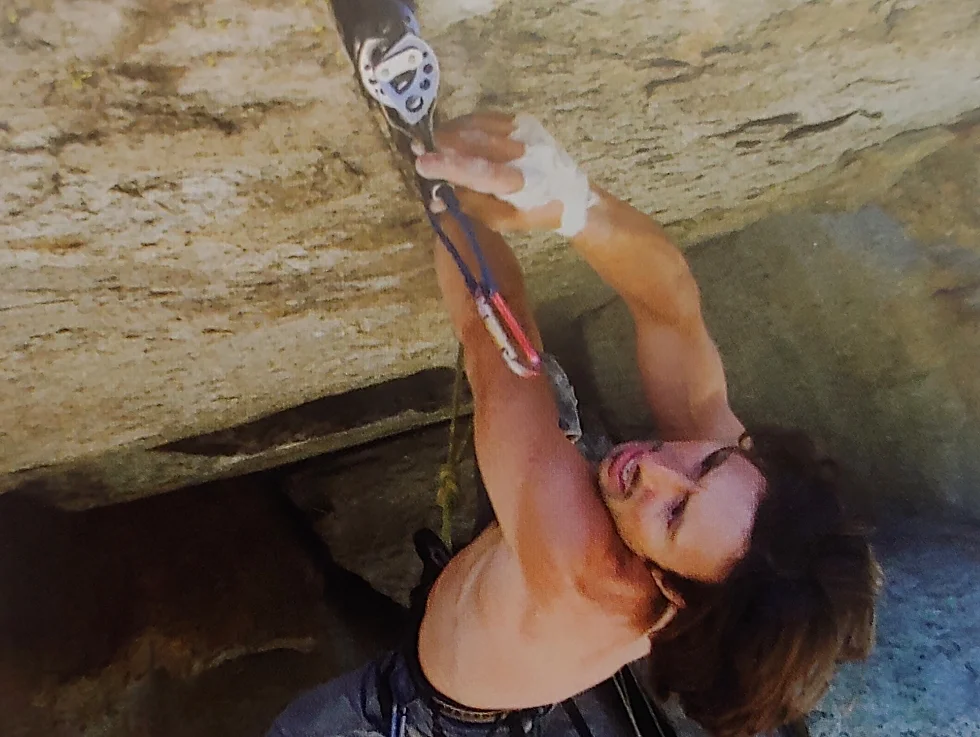
Being composed almost entirely of metamorphic rocks, the climbing style in the Valle dell’Orco is essentially granitic, with the exception of the lower valley cliffs where gneiss allows for progression on sometimes sharp, sometimes sloping holds, requiring good forearm endurance. Climbing on the structures in the upper valley is purely granitic. Slabs, corners, and cracks abound.
The cracks: The presence of sharp and regular cracks on a significant portion of the walls can be said to have played a decisive role in creating the myth of Valle dell’Orco. The fame of some of these, especially the Fessura Kosterlitz, has even crossed national borders, and many foreign visitors come to Valle dell’Orco specifically to attempt climbing them. The most famous cracks require a perfect mastery of jamming techniques, making them even more feared and sought after. Over the last twenty years or so, in Italy at least, this type of technique has remained the prerogative of a few selected climbers or aficionados of granite sanctuaries. Rarer are the cracks to be climbed in a chimney style or fingertip style (lie back). On the latter, it is not uncommon to find bolts, although they can be protected differently, making things significantly easier.
The corners: Although not as famous as cracks, Valle dell’Orco features some splendid corners of various difficulties, although they rarely reach considerable lengths. Some, like the Diedro Nanchez, span several pitches, while others are only 15 meters long, offering rough and strenuous climbing, such as the famous Diedro del Mistero.
However, the nature of gneiss, well-endowed with sharp edges and footholds, rarely necessitates long stretches of chimney climbing. More often, using the stemming technique allows for climbing while conserving energy.
The slabs: Although not as prevalent as in Val di Mello, slabs in Valle dell’Orco have played an important role in the local climbing history. As often happens, climbers specialize in their preferred style and terrain. The presence of small holds or crystals on even the smoothest slabs here has allowed climbing at inclinations beyond the typical friction climbing, making progression on this terrain less monotonous than elsewhere. Fortunately, the excavation of holds on slabs has remained a limited and controlled phenomenon.
On the rocks of Torre di Aimonin or Sergent, local slab climbers have pushed the standards very high, possibly beyond those reached on cracks. Naturally, as on all granite slabs, good technique, finger strength, and sturdy shoes are necessary.
Overhangs: Overhangs climbed or equipped on structures in the upper valley are extremely rare. It is a still relatively unexplored terrain, unless the overhangs are intersected by cracks, as in the case of the roof of Legoland or Greenspit. Conversely, in the cliffs of the lower part of the valley, climbing on overhanging terrain is often done, taking advantage of the providential holds offered by the gneiss. Unfortunately, it is quite common in almost all the cliffs to excavate holds, as was customary in the 1990s when these cliffs were developed. As you will notice, it is not always about excavating on impossible sections, but often to make the routes more consistent by eliminating blocking moves. This philosophy, popular in the early 1990s, has not yet been surpassed in Canavese, and many climbers still believe that the route setters did the right thing. It is a fact, however, that routes above 8a are extremely rare in the valley… and this is partly due to the systematic elimination of (apparently) impossible sections.
Bouldering: Despite the enormous potential, bouldering in Valle dell’Orco remains a sporadic practice, limited to the surroundings of Rosone and Ceresole, where some areas are undergoing development. Among all the boulders offered by the upper valley, only Masso Kostelitz has several documented and publicly known passages. Much remains to be done, and occasionally, a foreigner solves an isolated passage. However, currently, there is no community of boulderers regularly engaged in exploration and development.
Aid climbing: Aid climbing in Valle has had its boom in two well-defined historical periods and currently remains a practice for a few enthusiasts. The first aid routes date back to the early 1970s, the golden age of exploration of Caporal and Sergent. Among them, about ten have become classics and are regularly climbed in this style, although in recent years, some have been free climbed. These routes are mostly in the AI and A2 range, sometimes A3, and often have plenty of fixed gear in place. Specialized or cutting-edge equipment is rarely needed to repeat them, and almost all can be done in a single day.
In the 1990s, there was then the explosion of new-age aid climbing, essentially thanks to Valerio Folco, who imported American techniques onto the walls of the Valle. The second-generation aid routes, or if you prefer new-age, are rarely repeated today and remain the prerogative of a few enthusiasts. For those wanting to repeat them, it is advisable to consult the website www.valeriofolco.com to assess the required gear.
Sport climbing: Certainly, Valle dell’Orco is not the most beautiful place for a sport climbing holiday, and as is well known, granite is not the rock of choice for lovers of this activity. However, the cliffs of the lower valley, especially Frachiamo and Bosco, are very popular during the winter months among climbers from Canavese, and even from Biella and Turin. These cliffs are not exceptionally beautiful, but the fact that they are climbable in the rain, south-facing, and offer medium to high-level routes that are highly training-intensive has made them enjoy favor among enthusiasts.
Due to their small number, the cliffs in Valle dell’Orco are generally well-equipped and well-maintained by local climbers. Good access trails, drawings at the base with a list of routes, benches for comfortably belaying, and gravel to prevent dusting the ropes are common features.
Clean climbing: One of the discoveries of recent years (some would say re-discovery) is the Anglo-Saxon-style clean climbing. In short, it involves climbing free while protecting oneself with natural gear (nuts and cams) during the ascent. In recent years, routes have been developed with this approach, although currently, they rarely extend beyond one or two pitches. Essentially, these are short climbs where enthusiasts of this style can practice placing natural protection. In almost all cases, the belay stations are bolted, and sometimes there are one or two bolts along the pitches in sections where natural protection is not possible, although in this case, it cannot be considered clean climbing.
Until three or four years ago, it was possible to climb in this style only on some cracks or short sections of routes in Valle dell’Orco, and sometimes even these had bolts. Today, it seems that this additional possibility, which only enhances the charm of Valle dell’Orco, is gaining more and more followers and is consequently respected (meaning keeping routes clean) even by those who consider it elitist and dangerous.
Monopitches: On the basal rocks of the most famous walls in the upper valley, monopitches are often found, some completely bolted on slabs, others in a mixed style. It is advisable to equip yourself in advance with mobile protections where specified, without thinking that just because it is a single pitch, it must be climbable only with quickdraws. Free monopitches were always seen as a compromise, but today things are changing, and many climbers spend a day on the walls of the upper valley just to climb on monopitches. We can then add that routes of considerable length abound in the Alps, while places to practice granite monopitches, both bolted and unbolted, are still extremely rare in Italy. In this sense, the Valley still has much to offer, and that’s where the future will play out in the coming years.
Modern multipitches: Since the early 1990s, this new type of route has spread, essentially thanks to Manlio Motto at first, and later Maurizio Oviglia and Adriano Trombetta. Essentially, it is a style inspired by the routes on Monte Bianco opened by Michel Piola, which involves using bolts on slab sections and leaving room for mobile protection along the cracks. These routes are generally opened from the ground up, stopping with cliffhangers or in balance on footholds to place bolts. Each route setter, depending on their skill and the philosophy with which they open, gives their route a character that makes it more or less severe. The commitment often translates into the distance between two protections, expressed by the obligatory grade, i.e., the most difficult section that the climber must overcome between two protections, without the possibility of aiding themselves with other means than their free climbing ability. Although the obligatory grade is expressed as a grade, there are various interpretations of how to assign it, and these vary depending on the route setters. It remains a highly subjective and indicative parameter. Repeaters will not fail to form a personal opinion about the routes of one or another route setter, just like it’s a brand of a product. In fact, establishing correct opening criteria is a utopia: everyone has their concept of safety and their way of seeing a line. If you want a more precise idea of what you are going to face, refer to the S scale (see difficulty rating) that I elaborated with Erik Svab and Nicola Tondini, already adopted for some years by the Versante Sud guides. S1 roughly corresponds to the distance normally used in the cliffs or slightly more, and S2 to a distance between points between 4 and 6 meters. S3 and above routes are very psychologically demanding and require absolute mastery of the obligatory grade, meaning that it must be a grade that you normally climb on sight in cliffs and mountains on all types of terrain.

